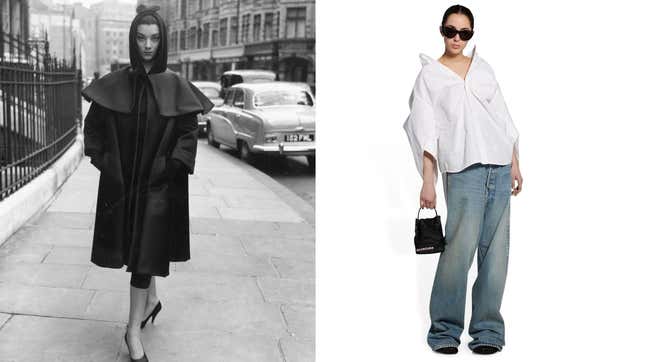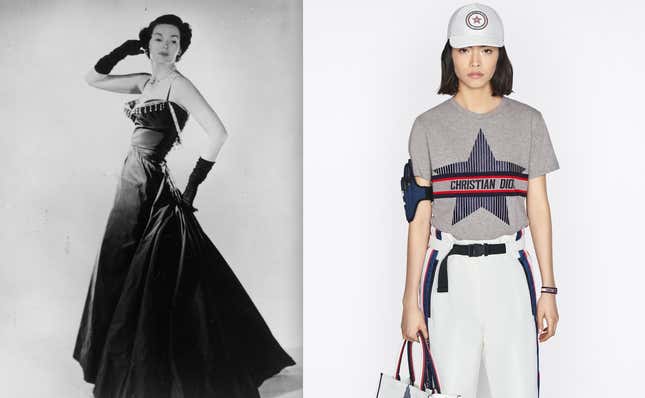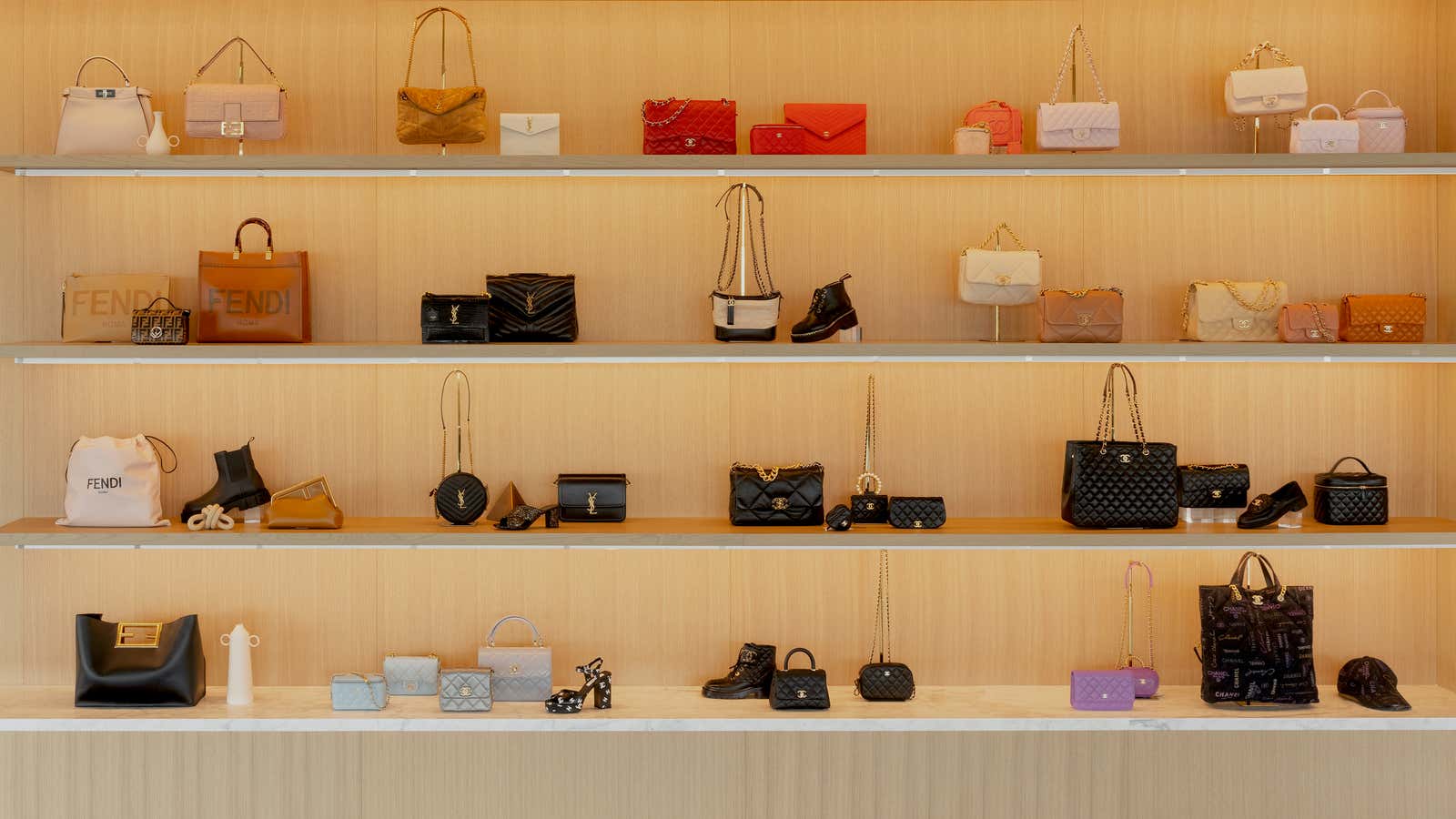When Sarah Davis brought her family to New York this past summer, her 18-year-old son didn’t want to just check out the Nike store. What he really wanted to see was the Nike x Louis Vuitton pop-up in Brooklyn, even if it meant waiting in a long line.
The exhibition, which featured 47 pairs of Air Force 1 shoes, was the last project of the late designer Virgil Abloh. Similar shoes designed by Abloh in another Nike collaboration had recently sold for over $100,000 a pair at Sotheby’s.
Whereas Abercrombie & Fitch, Nike, PacSun, and Gap once made up the mainstay of cool brands when millennials were teens, it’s nearly second-nature for Gen Z now to name check Demna Gvasalia, Glenn Martens, and Alessandro Michele (the designers at Balenciaga, Y-Project, and Gucci respectively).
Davis, who founded the secondhand luxury platform Fashionphile, says she can’t help but notice how much her son and his friends are into luxury.
“When I was growing up, luxury was something that the wealthy participated in,” Davis says. “There were fewer accessible entry points. Teenagers were not interested, let alone were they shopping luxury–and even fewer [could] buy it.”
This sharp difference between the generations didn’t happen by accident. A bold, decades-long shift to open up luxury’s shopper base to younger customers has dramatically exploded the sector and transformed the business of luxury goods.
Balenciaga, Louis Vuitton, and the power of streetwear
Balenciaga may have started out selling ballgowns, but it has undergone a streetwear-savvy makeover and now hawks sneakers and kitschy trash bags, too. Louis Vuitton, which began as a premium leather luggage specialist, surprised the industry when it collaborated with Supreme in 2017 in a pivot to a much younger crowd. Now, it regularly includes cotton printed tees and fragrances as part of its collection.


In 2019, millennials and Gen Z accounted for 40% of luxury shoppers in North America, and 44% for the industry globally, according to joint research by the consulting firm Bain & Co. and the Italian luxury goods association Altagamma. These generations are expected to account for as much as 70% of the global luxury market by 2025.
The youthfulness of China’s luxury market has been even starker. According to a joint study by BCG & Tencent, in 2015, two-thirds of luxury customers in China were under the age of 35. By 2021, the market had grown even younger. Half of China’s luxury buyers last year were born after 1990.
This broadening of the customer base has allowed the global luxury industry to more than triple its revenues from €43 billion ($44 billion) in 2000 to €130 billion ($133 billion) in 2021, according to research by Bank of America. It has swelled LVMH chairman Bernard Arnault’s fortune so that he now comfortably maintains a position in the top three of the world’s richest. (For a time in 2021, he was the wealthiest person on the planet.)
And there’s still more room for luxury to grow. Bank of America predicts that the youth-focused strategy adopted by the industry in the last two decades has doubled luxury’s total addressable market to €365 billion ($374 billion).
“Thirty years ago, there were voices saying that luxury has no future, because luxury was really that rich aristocratic European or East Coast lady who wore big gowns, [with her] husband in a tuxedo, and who went to big galas,” says Michael Kliger, CEO of Mytheresa, an online luxury fashion retailer. “That continues to be a lifestyle, but a very limited lifestyle.”
“You can go running in Gucci”
The huge success of luxury, particularly at big groups like LVMH and Kering—the former owns labels including Christian Dior, Fendi, Givenchy, and Marc Jacobs, as well as Louis Vuitton, and brands owned by the latter include Balenciaga, Gucci, Bottega Veneta, and Alexander McQueen—was to expand the selection of products so people had the option to wear it in many different situations, Kliger explains.
“You can go running in Gucci, you can go to lunch in Stella McCartney and [to] your studio,” Kliger says. “You can have casual luxury; it’s not always a suit.”
Although luxury inherently encompasses an element of exclusivity—and brands seek to main that aura at all costs—luxury goods have become ubiquitous.
Companies can pull this off by including enough accessibly priced options. Dior, for example, sells a pair of shoes for $470 or a cardholder for $390 so that first-time buyers can get a taste of the brand, while catering to their core customer set with a dress from the ready-to-wear collection that can easily cost $5,000. Haute couture, which is entirely custom-made, can fetch into the tens or even hundreds of thousands.
Fashion resale sites have also helped to groom a younger customer
By offering a more affordable entry point into owning designer goods, resale companies like Fashionphile are part of the pivot to young shoppers too.
“You really can buy vintage Louis Vuitton, Gucci, Fendi, Balenciaga, and even Chanel for less than $500,” says Davis. “My son can’t afford to buy luxury full retail, but he buys and sells sneakers and buys designer items second hand.”
The growth of online resale platforms Vestiare Collective and StockX has helped develop the aftermarket. In the process, they’ve enabled second-hand to lose a lot of its stigma too. In fact, Gen Z’s eco-consciousness and desire to wear unique goods to express individuality means they sometimes might even prefer it to buying a new season look straight off the rack.
Brands expanded into many new categories like sneakers and kidswear
But more so than the wider acceptance of pre-owned, it’s luxury’s expansion into new categories that has and been driving growth, namely in streetwear and children’s wear.
Bank of America estimates the luxury sneaker market grew from €3 billion in 2016 to roughly €7.7 billion in 2021, meaning a heady 21% compound annual growth rate. Luxury footwear overall, on the other hand, only saw average yearly growth of 3%, while footwear at large grew 2% in that same time period.
In 2021, sneakers accounted for around 8% of luxury goods but 30% of initial purchases, highlighting their strong ability to attract new customers to the luxury world.
Dior was a first mover when it started a kids line in 1967, but children’s wear launches have picked up the pace. At least 12 major fashion brands have launched designer clothes for tots and babies in the past two decades. Luxury ecommerce marketplace Farfetch quadrupled the number of childrenswear brands on its marketplace from 2016 to 2017, while another similar luxury ecommerce player Mytheresa launched its kidswear offering in 2019.
Despite the recent rise in luxury childrenswear collections, it is still a relatively untapped category, with luxury comprising 3.5% of the global childrenswear market versus 7.6% of the total apparel & footwear market. As these children grow, so does the opportunity. The younger people are started on luxury, the more lifetime spend a brand can earn from a customer.
Other expansions into beauty, home, and athleisure further lowered the bar for entry-level shoppers. People who can’t afford a $5,000 suit may still be able to afford a $200 candle or a $60 lipstick. Regular Loewe might be out of reach but the On Running x Loewe collaboration could be accessible to a shopper outside luxury’s historical demographic.
Culture’s luxury vibe shift
There’s also an undeniable cultural component to the embrace of luxury by young people. Social media has allowed people to peek into the ultra wealthy’s lives in a way that normalizes big consumption habits. Whether that’s a member of the Kardashian clan toting an ostrich leather Hermes Birkin to board a private jet, Ariana Grande singing about her diamonds, or Cardi B rapping about Gucci and Prada bags, luxury flexes are seemingly everywhere.
This has had a profound effect on American shoppers in particular. Anish Melwani, the CEO of LVMH USA, says that when he first joined the luxury conglomerate seven years ago, the level of awareness in American culture of luxury was much lower than across the Atlantic. At the time, LVMH even viewed the US as a sort of emerging market for luxury.
“Luxury has just become much more visible,” Melwani said in a wide-ranging interview with Quartz in October. “I don’t remember growing up hearing luxury brands in popular music the way that you do now. I think Gen Z is is growing up and has references to luxury in what they consume as popular culture, whether it be through music, movies, [or] social media.”
Bank of America’s analysis of Billboard year-end Hot 100 singles found that mentions of luxury brands and luxury product has skyrocketed in recent years, with a visible upward trend starting from the early 2000s. Meanwhile, the bank’s researchers found that 13 of the top 20 most followed Instagram accounts put a spotlight on the luxury goods industry one way or another.
The bank also compared name drops of luxury fashion goods to cars brands. In the 1970s, there was just one luxury brand mentioned in the Billboard year-end Hot 100 singles, while 44 car brands got mentioned. By the 2000s, there were 123 luxury brands mentioned vs. 317 car brands. And in the 2020s, there were 817 luxury brands mentioned compared to 630 car brands, reflecting Gen Z’s growing disinterest in cars relative to its embrace of designer clothes and accessories.
The peak year for luxury brand mentions in hit songs was 2017. But the song Gucci Gang, which came out the year after, takes the cake for most mentions. It references Gucci 104 times over 2 minutes and 10 seconds.
Beyonce’s 2022 album Renaissance also demonstrates luxury’s new resonance. There were 22 mentions of luxury brands in her songs on that album, but none in her 2003 album Dangerously in Love, Bank of America found. It’s also worth noting that last year, Beyonce and her rapper-husband Jay Z were tapped by Tiffany & Co. for a massive advertising campaign to re-energize the jeweler.
Luxury companies are likely to get louder too
Just how were luxury labels able to infiltrate the zeitgeist so powerfully? Selling to the affluent, as it turns out, is a good business that holds up better than the rest of retail when the economy stalls. Shoppers who can afford expensive wardrobes are less affected by downturns, so revenue and margins tend to remain strong. Brands reinvest this revenue into bolstering future brand desirability, which in turn fuels more revenue growth, thus creating a positive feedback loop.
Last year, luxury companies spent over €12 billion on advertising, more than double their €5.7 billion ad budget from 10 years ago, according to Bank of America. From 2010 to 2019, the group of luxury brands that the bank analyzed increased their ad spending by over 140%, outpacing the 95% growth for advertisers generally, which means Prada, Louis Vuitton, and the like are capturing a larger share of the ad market.
If the world tips into a recession, this effect is going to be exacerbated. Many retail companies are turning more conservative in the current economic climate and are trying to trim costs. While not totally immune, luxury companies are set to post 21% revenue growth this year.
